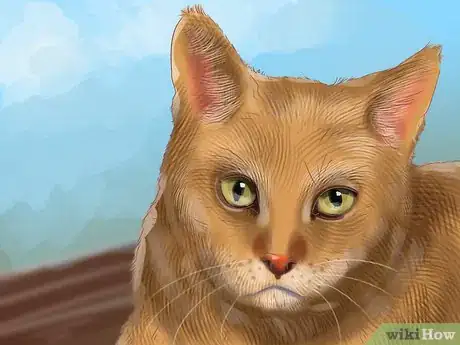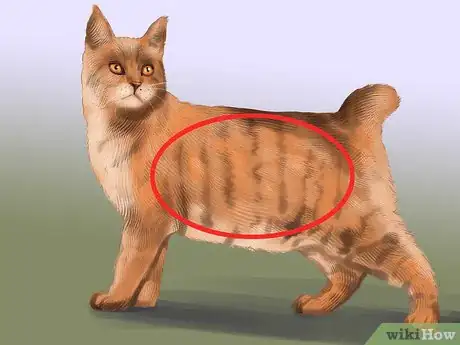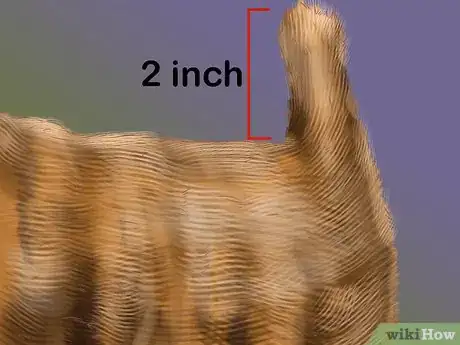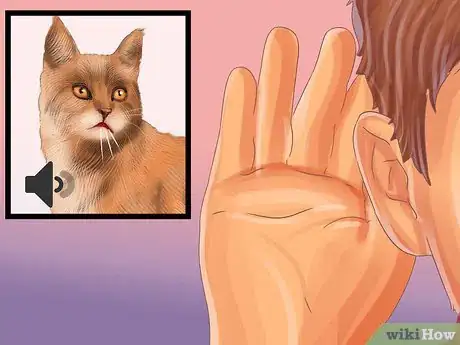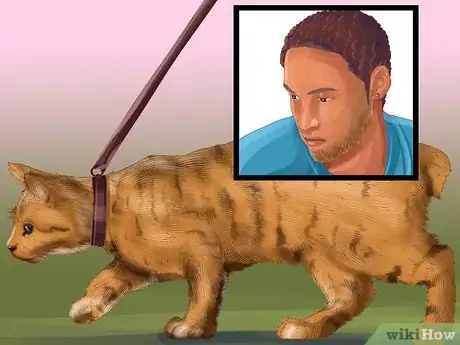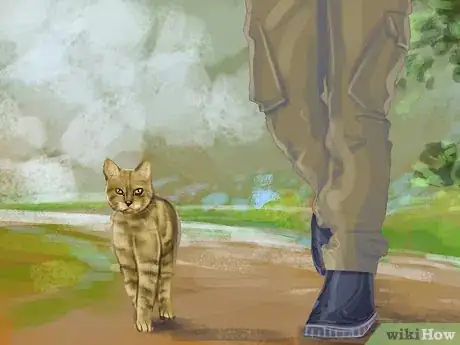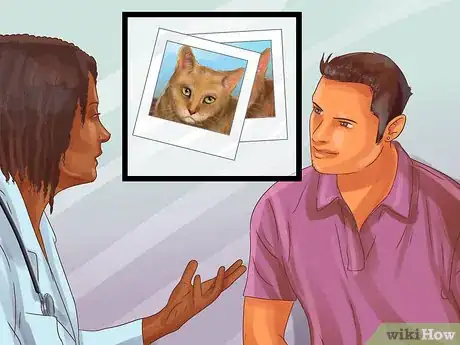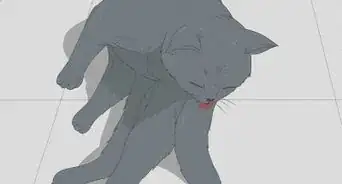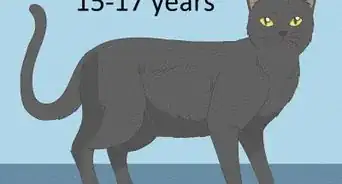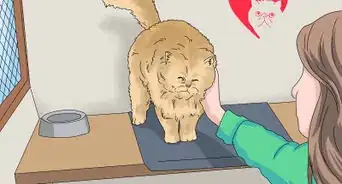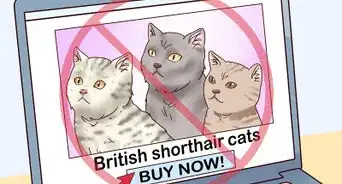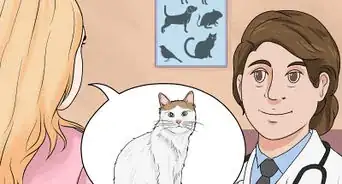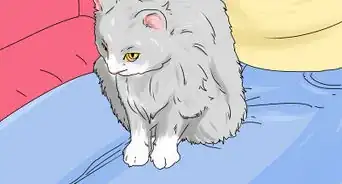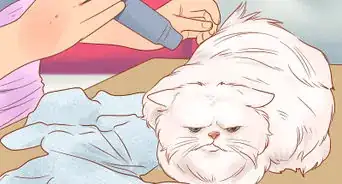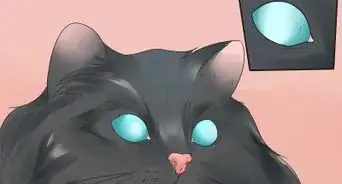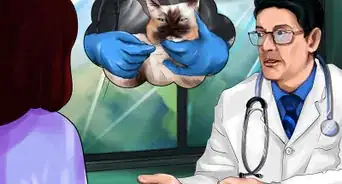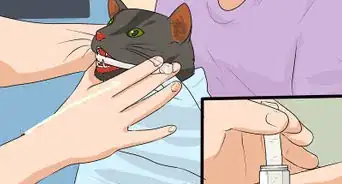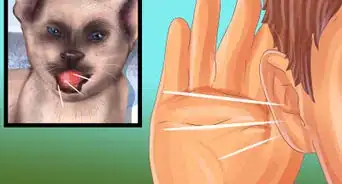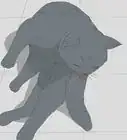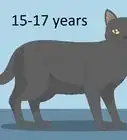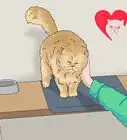This article was co-authored by Pippa Elliott, MRCVS. Dr. Elliott, BVMS, MRCVS is a veterinarian with over 30 years of experience in veterinary surgery and companion animal practice. She graduated from the University of Glasgow in 1987 with a degree in veterinary medicine and surgery. She has worked at the same animal clinic in her hometown for over 20 years.
This article has been viewed 31,976 times.
The pixiebob cat is a domesticated cat, but has physical features that make it resemble the wild bobcat. They are also loyal, loving, and sociable, so they love to spend time around people.[1] Because of these characteristics, pixiebobs tend to make great family cats. By observing their physical attributes, paying attention to their personality, and consulting professionals, you’ll be better able to identify a pixiebob cat.
Steps
Observing Physical Attributes
-
1Verify the cat’s shape and size. The pixiebob cat is a medium sized cat and has a sturdy build. Their build is one of the reasons why many people suggest that it is related to the wild bobcat. When evaluating its shape and size consider that:
- The cat weighs between 8 to 17 pounds (3.6 to 7.7 kilograms).
- They are muscular or brawny.[2]
-
2Observe facial hair and color. One of the most distinguishing features of the pixiebob is its facial hair. Ultimately, these characteristics are some of the most important in making the pixiebob resemble a bobcat. Some characteristics include:
- The cat may have lynx tips on the ears.
- Their hair may grow down along the sides of their face and resemble muttonchop sideburns.
- The cat may have mascara markings that run from the outside corner of the eye to the cheek.[3]
Advertisement -
3Examine the cat’s coat. The pixiebob has a thick coat that is relatively resistant to the elements. Thus, the pixiebob is well suited to the outdoors in colder climates. Ultimately, by looking at the cat’s coat, you’ll get a better idea of whether it is a pixiebob. The coat:
- Is soft, thick, and has a woolly feeling.
- May be shorthair or longhair.
- Is usually brown spotted and tabby colored. It could be many different shades of brown.
- Will have a spotted stomach.[4]
-
4Look for a short tail. One of the defining characteristics of the pixiebob is its short tail. This, combined with the cat’s facial hair and color have led many people to suggest that the cat might be related to the bobcat.
- Pixiebob tails may be as short as 2 inches, but they can sometimes be much longer.
- Their tails may be kinked or even knotted.[5]
-
5Check for extra toes. Pixiebobs often have extra toes, which is also known as polydactylism.[6] A cat with extra toes is not automatically considered a pixiebob, but this is something you should consider along with other physical traits.
Assessing the Cat’s Personality
-
1Listen to the cat. Whereas some cats are extremely vocal, pixiebob cats are not. In fact, they’re notoriously very quiet. Thus, listen carefully to a cat you suspect is a pixiebob.
- These cats won’t make too much noise. For example, they won’t meow loudly for food or attention.
- Instead of meowing or making noises, the cat may raise its paw to gain your attention.
-
2Observe to see if the cat acts like a dog. Many pixiebob owners comment that the cat is almost dog-like when it comes to its loyalty and devotion to its family. Thus, when you’re trying to identify the pixiebob, watch to see if its behavior is somewhat like a dog.
- They may be taught to walk on a leash or harness.
- You may be able to teach your pixiebob to fetch.
- Pixiebobs will often lounge around the house nearby the family.[7]
-
3Notice if the cat is affectionate. Unlike some other cats, pixiebobs are very affectionate. They’ll regularly show you that they love you and want to be around you. When observing their affection, remember:
- Pixie-bob Cat aren’t really lap cats. Rather, they’ll stand or sit by your side and follow you around.
- They may sleep right next to you in bed or on the couch.
- They often hang out at the front door waiting for their owners to return from school, work, or elsewhere.[8]
Consulting Professionals and Reference Materials
-
1Talk to a veterinarian. Your veterinarian is one of the best resources in helping you confirm if a cat is a pixiebob. Ultimately, your vet will have substantial experience interacting with a wide variety of cat breeds.
- Ask your vet their opinion.
- If you don’t possess the cat, take pictures and show them to your vet.
- Some vets may or may not require you to make an appointment to give their opinion about the breed of your cat. Phone ahead and ask the office staff to find out their policy.
-
2Consult an expert. If you’re still unsure that a specific cat is a pixiebob, you may want to consult an expert. There are a wide variety of professionals who may be able to help you positively identify a cat as a pixiebob. Consider:
- Contacting a pixiebob breeder. Since the cat is commonly viewed as a hybrid and is a new breed, you may not be able to locate a pixiebob breeder in your community. However, you may consider contacting a breeder via email and asking them if they’d mind looking at pictures and giving you advice.
- Talking to a representative of a cat association. There are several national and international clubs dedicated to promoting diversity of cat breeds. While some do not recognize the pixiebob, others do. For example, contact The International Cat Association, which does recognize the pixiebob.[9]
-
3Look into DNA testing. There are companies that will test the DNA of your cat and let you know what breed they are. All you have to do is take a swab of your cat’s cheek and then send the swab away to the lab. Find a company that has a large database of cat DNA available to get the most accurate results.
-
4Educate yourself about the pixiebob. The pixiebob cat itself is a relatively new breed. It is native to the United States. Ultimately, by learning some of the basics about the pixiebob, you’ll have more information you need to help identify them.
- The pixiebob was unheard of until 1985.
- The cat is native to the Pacific Northwest.
- Breeders have selectively bred the cat since its discovery in the mid-1980s.
- Since the pixiebob is a relatively new breed, DNA tests may be unable to distinguish it from other house cats.[10]
References
- ↑ http://www.vetstreet.com/cats/pixiebob#personality
- ↑ http://tica.org/cat-breeds/item/252-pixiebob-introduction
- ↑ http://tica.org/cat-breeds/item/252-pixiebob-introduction
- ↑ http://www.vetstreet.com/cats/pixiebob
- ↑ http://tica.org/cat-breeds/item/252-pixiebob-introduction
- ↑ http://www.vetstreet.com/cats/pixiebob#history
- ↑ http://tica.org/cat-breeds/item/252-pixiebob-introduction
- ↑ http://www.catster.com/cat-breeds/Pixie_Bob
- ↑ http://tica.org/cat-breeds/item/252-pixiebob-introduction
About This Article
To identify a pixiebob cat, first examine its facial hair to see if it has lynx tips on its ears, which can indicate a pixiebob. You should also look closely at its body shape, as a typical pixiebob has a muscular build and a very short tail. Aside from physical appearance, notice the behavior of your cat to see if it has pixiebob behaviors, such as being quiet and using its paws to get your attention. You may also notice pixiebob cats tend to have affectionate dispositions and can easily be taught to walk on a leash. To learn how to get a DNA test for your cat to find out what breed it is, read more from our Veterinary co-author!

